Inflamed mucous membranes or itchy skin
The people concerned at first suffer general malaise, that can not clearly be associated with any specific disease. These symptoms may include watery eyes, inflamed mucous membranes, or itchy skin. Scientists analysed whether these persons were exposed to elevated concentrations of pollutants at the workplace, but on the whole there was no connection between exposure to pollutants and their afflictions.
The Anglo-Saxon term “Sick Building Syndrome” (SBS) has been adopted by experts to refer to these non-specific afflictions experienced by people who spend time in these buildings. Feeling ill in a building that “makes you sick” must be stated in inverted commas precisely because it is not quite clear whether anything specific or at all about the building leads to these disorders. Sick Building Syndrome must therefore be distinguished from Building Related Illness (BRI), as the latter can be proven through existing measurable, negative influences of the building. Nowadays, SBS and BRI should not be underestimated for the challenge it poses to indoor air hygiene.
The ProKlimA study
Scientists have carried out both comprehensive national and international studies to investigate the phenomenon of SBS and its causes. The most well-known of these in Germany is the ProKlimA-Study in which the University of Jena and research partners surveyed some 5,000 subjects employed in offices from 1994-2000. Questionnaires and exhaustive measurements at the workplace as well as clinical data helped experts to determine the frequency and causes of health complaints. Results have been published in an extensive report. Offices with air conditioning systems were not more contaminated with pollutants than those without; in fact, they were often less so. Yet, most of the SBS cases registered stemmed from rooms with air conditioning, and there is no real explanation for this. It is most certainly due in part to some individuals’ general discomfort about “air conditioning” and a preference for “traditional” airing by opening windows. Pollution of indoor air, for example with volatile and semi-volatile organic compounds in German (VOC and SVOC), infestation with microorganisms and other factors were widely varying on the whole and only seldom played a part in sufferers’ afflictions.
The studies have demonstrated that individual factors and sensitivities of those concerned, their job, and the user-friendliness of the workplace were often far more indicative of Sick Building Syndrome that any influence exerted by the office building itself. However, many questions remain unanswered and must be addressed by experts in the fields of indoor space and occupational psychology.
